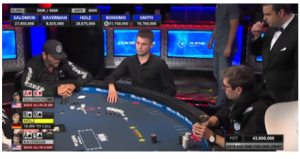Introduction and Project Summary
Our project aims to help digitize the analysis of poker in real-time. Poker at a professional-level requires an in-depth understanding of the current state of the game. Primarily, our system image and classify cards as they are dealt. This information will be displayed to a web interface for audience members/commentators to watch the game unfold. The information will also be tabulated at the end of the game for further review and analysis.

Normally this is achieved through small cameras in or around the rim of the table (as seen above) however this is not automated and requires a technician to manually review the footage and update the cards accordingly. Our system will fully automate this process.
Sid’s Status Report for 2/20/2021
This week, I spent most of my time trying to refine our project’s scope to ensure I would be contributing a reasonable amount. After discussing internally as a team on 2/15, we initially revisited the idea of using RFIDs. Because I have taken 18330, I considered implementing cryptography between the RFID tags and readers. I spent most of 2/15 and 2/16 doing research on the feasibility and effectiveness of encrypting communication between tags and readers. After our meeting on 2/17, we decided as a group to focus more on image processing and using the camera for computer vision. Hence, I realized my best contribution would be in training our ML model, experimenting with various models and hyperparameters for the best results, and developing the web app for visual display. I created and updated our proposal presentation slide deck with our recent design changes, and I plan to spend the rest of today making more updates. So far, I am right on schedule. Next week, I hope to dive into further research over the best ML models to utilize and which resources/tools I’ll use for the web application. This will help in creating the design review presentation.
Team Status Report for 2/20/2021
Our meetings on 2/8 and 2/10 were used to determine our idea: digitizing the professional poker experience by automatically counting and displaying cards for commentators/audience members. We met on 2/15 and 2/17 to further refine the scope of our project. During these sessions, our main purpose was ensuring that our project was broad enough such that everyone would have a fair share of work to accomplish. However, we didn’t want to make the project too broad, as this could make our ideas infeasible and unconnected.
After meeting with Professors Gary and Tamal and talking to our TA Ryan, we decided to stray away from RFID and focus mainly on the following topics: creating custom hardware, performing CV and signal processing through images from a camera, and training/experimenting with various ML models to find the best latency and throughput. Jeremy will work with the imaging pipeline and signal processing. Specifically, he will contribute to designing the lighting, camera geometry, and camera optics to boost image classification accuracies. Sid will help train and configure the ML model and build a web app to display the status of the game. He will work on experimenting with various models and hyperparameters. Ethan will contribute to building custom hardware and assisting with the drivers. He will work on PCB fabrication, spec controllers/sbcs, and the hardware trigger.

